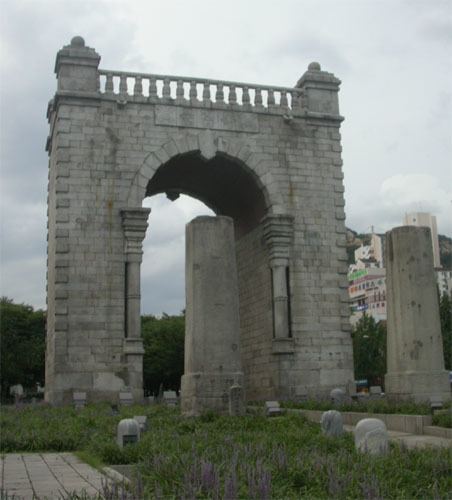Hangul 독립문 Revised Romanization Dongnimmun Phone +82 2-364-4686 | Hanja 獨立門 McCune–Reischauer Tongnimmun Architect Afanasy Seredin-Sabatin | |
 | ||
Similar Yeongeunmun, Seodaemun Prison, Seodaemun Independence Park, Dongnimmun Station, Donuimun | ||
Dongnimmun independence gate seoul korea
The Independence Gate (Hangul: 독립문; Hanja: 獨立門) is a memorial gate located in Seoul, South Korea. The gate was built following the First Sino-Japanese War to inspire a spirit of independence away from Korea's previous status as a Chinese tributary state, which was declared by the Treaty of Shimonoseki. It was designed by Soh Jaipil, a Korean political activist.
Contents
- Dongnimmun independence gate seoul korea
- Dongnimmun gate better known as independence gate in seoul south korea
- Description
- Location
- References
Dongnimmun gate better known as independence gate in seoul south korea
Description
The Independence Gate was built to replace the Yeongeunmun Gate, which was a symbol of diplomatic relations between Korea and Qing Dynasty China. To raise funds for the building, the Independence Club collected contributions. The two supporting pillars of Yeongeunmun Gate remain in front of the Independence Gate.
Construction of the gate began on November 21, 1896, and it was completed on November 20, 1897.
The design, by Soh Jaipil, was modeled on the Arc de Triomphe in Paris. It measures 14.28 meters in height, 11.48 meters in width, and is made of approximately 1,850 pieces of granite.
While the Independence Gate once straddled Tongil-ro, it was moved in 1979. to accommodate the construction of the Seongsan-ro. It now stands in the Independence Park, about 70 meters northwest from its original position. Access to the gate was restricted for much of its history, but it was reopened following the completion of Seodaemun Independence Park on October 28, 2009. Visitors can now walk under the gate itself.
On July 4, 1896, Soh Jaipil wrote an editorial in Independent News expressing his congratulations on the independence of Korea from the rule of Qing.
English
Thanks to the will of the God, Korea, after many suns (years) of serving as a vassal state of the Qing Dynasty, has become a fully independent nation. Now, the monarch of Korea is on equal footing with the world's leaders, and the Korean people are free. Because of the significance of this auspicious event, this symbol will serve as a reminder to the world and to future generations of Koreans of Korea's everlasting independence as well as be a place where the Korean public can exercise and enjoy the fresh air, quiet, and scenery.Modern Korean (한국어)
조선이 몇 해를 청나라의 속국으로 있다가 하나님 덕에 독립이 되어 조선 대군주 폐하께서 지금은 세계의 제일 높은 임금들과 동등이 되시고, 조선 인민이 세계에서 자유로운 백성이 되었으니, 이런 경사를 그저 보고 지내는 것이 도리가 아니요, 조선 독립된 것을 세계에 광고도 하며, 또 조선 후생들에게도 이때에 조선이 분명하게 독립된 것을 전하자는 표적이 있어야 할 터이요. 또 조선 인민이 양생을 하려면 맑은 공기를 마셔야 할 터이요, 경치 좋고 맑은 데서 운동도 하여야 할지라.— Independent News, July 4, 1896
Location
Seodaemun Independence Park, including Independence Gate, is easily accessed from exits 4 or 5 of the Dongnimmun Station on Seoul Subway Line 3.
